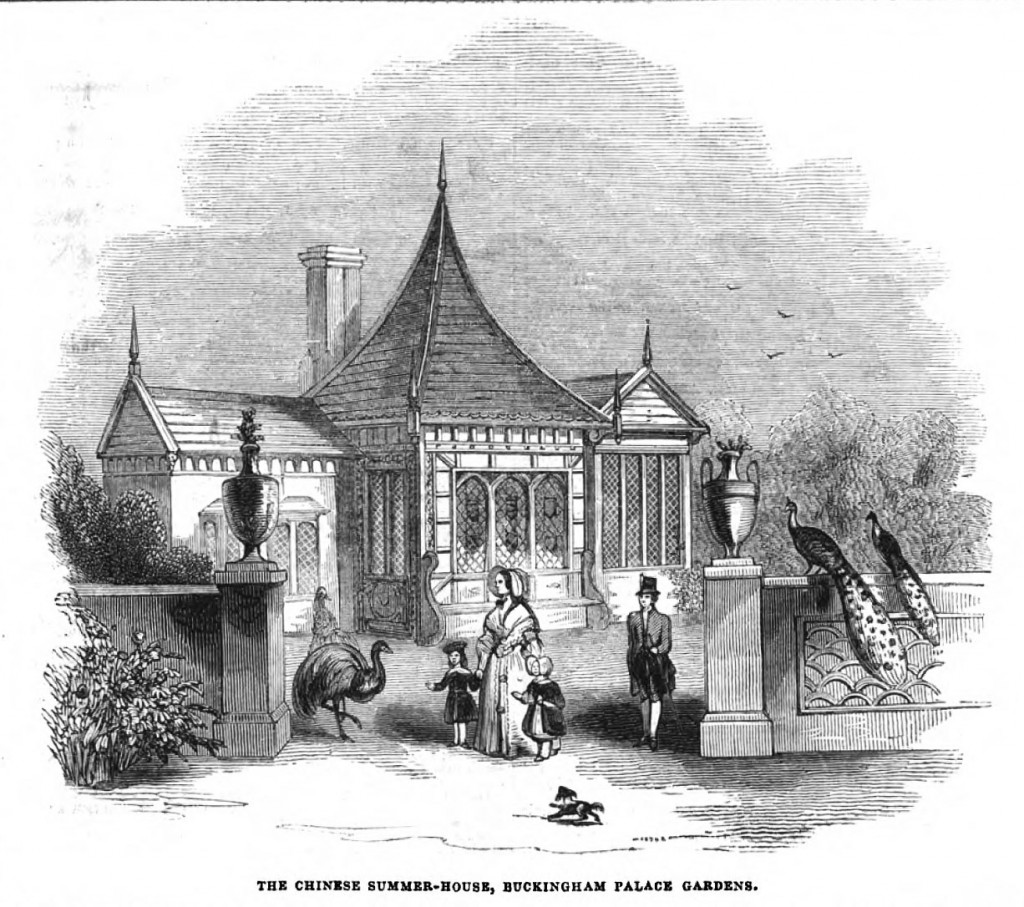The Chinese Summer-house, Buckingham Palace Gardens
From The Illustrated London News, 4 (1844): 305. (This article was published on 11 May, 1844, during the spring exhibition at the Royal Academy. The following article in the newspaper covers the exhibition and includes brief comments on the scenes from Comus exhibited by Leslie, Maclise, and Etty. Sourced from HathiTrust.)

The exhibition at the Royal Academy of three of the finished studies for the frescoes ordered by her Majesty for the embellishment of the Chinese Summer-house in Buckingham Palace Gardens, having called public attention to that building, we have prepared a view of it, which will, we hope, enable our readers more readily to understand the circumstances under which these--our first English frescoes--will be seen.
The Summer-house is a small octagonal structure, which crowns the summit of an artificial hill, built without any design to be richly decorated; and, therefore, not calculated for the proper display of the treasure it contains. The light is obtained from a latticed door and four small latticed windows, and does not fall happily on the pictures. The style of architecture is in accordance with the architect's whim; at least it belongs to no order; this may be no very serious objection, considering that it was intended to be little more than a garden seat; but it is an evil, now that it is likely to become an object of universal interest and attraction. The one room of which it consists (we take no account of two small apartments behind, and the aviary, which forms an underground floor, falling with the hill), is, as we have said, octagonal--but an irregular octagon; two of the eight sides being much larger than the other six. From these eight sides run up to a point in the roof, sixteen compartments; eight of these compartments being occupied with a design in arabesque by Mr. Aglio, which that gentleman has executed in encaustic.
The encaustic colours are very brilliant; the frescoes are, on the contrary, somewhat dull; so that the glaring hues of Mr. Aglio go far to kill the tones of Mr. Leslie and Mr. Maclise, while Mr. Aglio himself sustains much injury by their neighbourhood; for in his designs he has introduced several figures, semi-human; and has been placed at a manifest disadvantage in being seen in juxtaposition with the first artists of the age. This is an evil which time will not remedy; but as the interior of the building is not quite finished, much may yet be done to give the frescoes "fair play."
The poem illustrated is "The Masque of Comus;" and the frescoes are (or rather are to be) in number eight; the artists charged with their execution being Messrs. Eastlake, Leslie, Stanfield, Maclise, Etty, Uwins, E. Landseer, and Sir William Ross. Mr. Eastlake and Mr. Landseer have not commenced theirs; the other six have completed their works; and of these we are enabled to speak in terms of the highest commendation, although we have great fears of the durability of the colours--some of which, we are told, have already sunk in an injurious degree.
The neighbourhood of the Summer-house is enlivened by the presence of a number of foreign birds, which are especial favourites of the Royal children.
